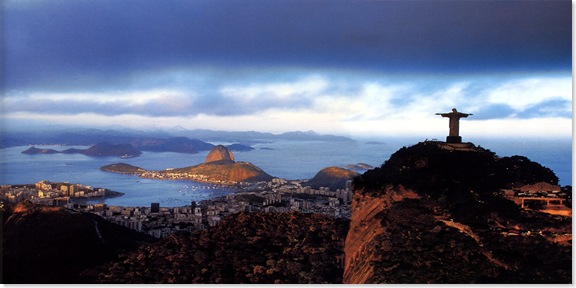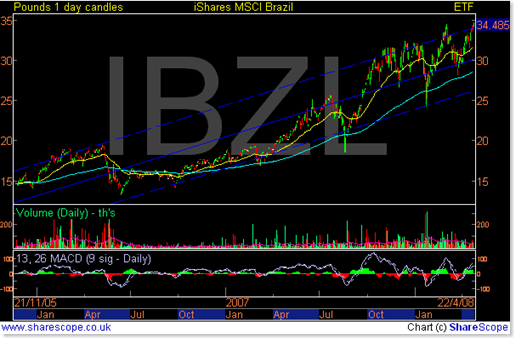Investing in Brazil
A few Years ago Morgan Stanley came up with the original idea that four big countries – Brazil, Russia, India and China – would together soon become so important in the world economy that they could be viewed as a single group, much as we think of Europe or Latin America.
They dubbed the group BRIC, after the first letters of their names, saying that their combined economies, from being just 15 per cent the size of the world’s six most advanced countries’ – including the US and Japan -- would grow to become even larger than them in combination in fewer than 40 years.
There has been a lot of focus on India and China and I have written about these countries in past articles Broken China ?? & Investing in India The challenge with both these countries is that they do seem to still be linked to the fortunes of Wall Street and have suffered along with the US Markets
Brazil and Russia, by contrast, are among the handful of countries best situated to supply those increasingly valuable natural resources and so are fairing a lot better and seem less exposed to the US story and more exposed to the Commodities and Energy story that is doing well in the face of the US recession.
Russia is a huge exporter of oil and natural gas, nickel and platinum group metals. Brazil is the world’s biggest supplier of internationally-traded agricultural products such as sugar, soybeans, coffee, corn, orange juice, beef and poultry.
Both still have enormous resources that can be developed to meet Asia’s growing demands.
No shortages of energy, food or water
Last year Brazil’s main stockmarket index rose 71 per cent in US dollar terms, or even faster than India’s, suggesting that international investors are awakening to the potential of the South American giant.
Much of that interest was focused on Brazil’s two biggest stocks – Vale (NYSE:RIO) and Petrobras (NYSE:PZE). Vale is the world’s biggest exporter of iron ore; Petrobras has just made the world’s second-largest oil/gas discovery in 20 years, deep beneath Atlantic waters.
But it’s renewable resources, rather than minerals, that are increasingly attracting investor interest.
The well-known British investor, Jim Slater, says Brazil is “insulated against the world’s main shortages – fresh water, agricultural commodities and energy.”
It contains nearly a fifth of the world’s fresh water, available to expand agricultural production and carbon-free electricity generation. Hydro-power already provides 80 per cent of Brazil’s electricity needs, and two big new dams are being built on the Amazon at a cost of $10 billion.
Because it can produce alcohol fuel from sugarcane, without subsidies, for prices competitive with petrol, Brazil has been dubbed “the Saudi-Arabia of ethanol.”
David Fuller, the London-based analyst, says: “No country is better positioned to benefit from the agricultural boom than Brazil, with its large and fertile land mass, absence of any desertification, and ample supply of fresh water.”
Other commentators point to the nation’s economic growth rate (around 5 per cent a year), a foreign trade surplus (running at about $40 billion a year), large foreign reserves, a strong currency and a buoyant stock market.
Last year Brazil attracted FDI (foreign direct investment in factories and business operations) of $37 billion, or twice as much as India. It was the world’s third biggest raiser of investment capital via equity issues after the US and China. And its international bonds are expected to be granted investment-grade status within two years.
Brazil has a flourishing middle class of 20 million – depending how you define “middle class,” five times larger than India’s – as well as political stability, a favourable environment for foreign investment, and strong job creation (5 million new jobs since 2000).
Years of favourable international environment, combined with good policies such as more disciplined public finances and trade liberalization, have delivered low inflation and falling interest rates. One result is the emergence from poverty of a new lower-middle class, so the nation’s notorious income inequality has been declining.
Sensitive to foreign capital flows
What are the negatives?
The public sector is bloated and corrupt, packed with time-servers with jobs for life and fat pensions to look forward to. Taxes to pay for it gobble up more than a third of national output – a proportion much higher than in other emerging markets and out of proportion to the low quality of services provided.
As is commonplace in countries where planning, building and operating infrastructure is almost entirely in the hands of bureaucrats, Brazil has some serious infrastructural problems, including power-supply shortages. The regulatory environment is not sufficiently clear to attract private investment.
Labour laws are highly restrictive, with welfare and other compulsory contributions adding 60 to 100 per cent to employers’ payrolls.
The stockmarket is very sensitive to flows of foreign capital, therefore exposed to adverse money shifts that may be triggered by developments unconnected with conditions in Brazil itself, such as the US sub-prime crisis.
Finally, remember that although Goldman Sachs’ BRIC study projected good per capita growth rates for the Brazilian economy over the coming decades, it suggested the three other nations in the group would grow even faster.
If you are interested in adding Brazil to your international portfolio to provide balance, the best way to do so is probably via one of the exchange traded funds listed in London or New York. There is an iShares MSCI Brazil Fund in London which I would favour as it is priced in Sterling and not Dollars or there is the Brazil Fund (BZF) that trades in new York if you are looking for a dollar denominated fund.
Best wishes
Alan


|